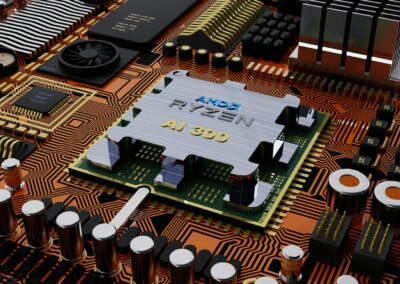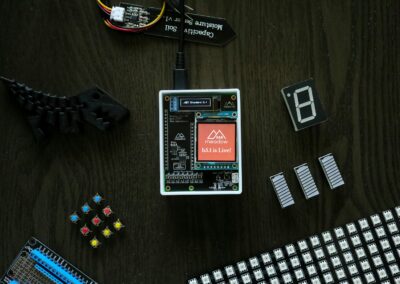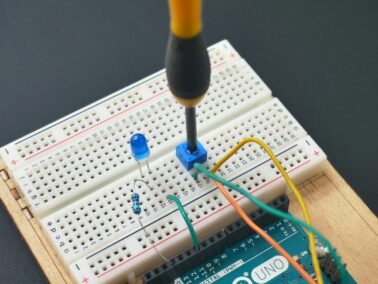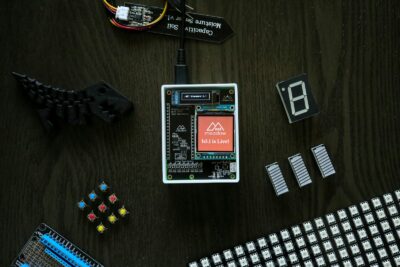Transforming IoT with Edge Computing: A Strategic Overview
Understanding the Role of Edge Computing in IoT
Implementing edge computing for low-latency IoT data handling is becoming a crucial strategy for organizations aiming to optimize the performance of their IoT applications. As IoT devices proliferate across sectors such as healthcare, manufacturing, and smart cities, the need for real-time data processing has never been more critical. Edge computing addresses this challenge by bringing data processing closer to the source, reducing the latency that often plagues cloud-based IoT systems. In regions like Saudi Arabia and the UAE, where technological innovation is rapidly advancing, edge computing is set to play a pivotal role in enhancing the efficiency and responsiveness of IoT systems.
One of the primary benefits of edge computing in IoT is its ability to reduce latency by processing data at or near the source. This is particularly important in applications where milliseconds can make a significant difference, such as autonomous vehicles, real-time health monitoring, and industrial automation. By processing data locally, edge computing minimizes the time it takes for data to travel to centralized servers and back, ensuring that IoT systems can respond almost instantaneously to critical events.
In Riyadh, for example, smart city initiatives are increasingly relying on edge computing to manage the vast amounts of data generated by connected devices throughout the city. From traffic management systems that adjust signals in real-time to environmental sensors that monitor air quality, edge computing enables these systems to function with the speed and precision required for effective urban management. The ability to handle data at the edge not only enhances the performance of these systems but also reduces the strain on central networks, ensuring that critical services remain operational even during peak usage times.
Enhancing IoT Infrastructure with Edge Computing
Building an IoT infrastructure that leverages edge computing for low-latency data handling requires a strategic approach that considers both the technical and operational aspects of deployment. One of the key considerations is the integration of edge computing with existing cloud-based systems. While edge computing brings data processing closer to the devices, the cloud still plays a vital role in long-term data storage, analytics, and large-scale decision-making. The challenge lies in creating a seamless integration between the edge and the cloud, ensuring that data can flow efficiently between these layers without bottlenecks or loss of information.
In Dubai, where smart city projects are at the forefront of technological development, organizations are exploring hybrid models that combine the strengths of edge computing with the scalability of cloud services. This approach allows for real-time data processing at the edge, while still leveraging the cloud for more complex analytics and historical data storage. For instance, a smart building in Dubai might use edge computing to manage its internal environment in real-time, adjusting lighting, temperature, and security systems based on immediate data inputs. Meanwhile, the cloud can analyze long-term trends and provide insights that inform future building management strategies.
Moreover, the implementation of edge computing in IoT infrastructure must also consider the scalability of the solution. As the number of connected devices continues to grow, particularly in large-scale projects like smart cities or industrial IoT, the edge computing framework must be able to scale efficiently to handle increasing data loads. This scalability ensures that as new devices are added to the network, the system can continue to operate with low latency, maintaining the high performance expected of modern IoT applications.
Security and Data Privacy in Edge Computing for IoT
While edge computing for low-latency IoT data handling offers numerous benefits, it also presents unique challenges, particularly in the areas of security and data privacy. Processing data at the edge means that sensitive information is handled closer to the source, which can reduce the risk of data breaches during transmission. However, this also means that edge devices become prime targets for cyber-attacks, necessitating robust security measures to protect both the devices and the data they process.
In the UAE, where data privacy is a top concern, organizations are focusing on implementing strong encryption protocols and secure access controls to protect data at the edge. These measures ensure that even if an edge device is compromised, the data it handles remains secure and inaccessible to unauthorized users. Additionally, regular updates and patches are essential to maintaining the security of edge devices, particularly in environments where new threats emerge rapidly.
Furthermore, edge computing can enhance data privacy by allowing for more localized data processing. In healthcare applications, for example, patient data can be processed at the edge, ensuring that sensitive information does not need to be transmitted to central servers unless absolutely necessary. This localized processing reduces the risk of exposure and ensures compliance with strict data privacy regulations, which are particularly stringent in regions like Saudi Arabia. By balancing the need for low-latency data handling with robust security and privacy measures, organizations can fully leverage the benefits of edge computing in their IoT applications.
Strategic Implementation of Edge Computing in IoT
Case Studies: Edge Computing in Action
The practical application of edge computing for low-latency IoT data handling can be seen in several successful case studies across the Middle East. In Saudi Arabia, a leading oil and gas company implemented edge computing to monitor and manage its extensive network of drilling sites. By processing data at the edge, the company was able to detect and respond to equipment malfunctions in real-time, significantly reducing downtime and operational costs. The low-latency capabilities of edge computing ensured that critical alerts were delivered without delay, enabling rapid decision-making in high-stakes environments.
Similarly, in Dubai, the adoption of edge computing in smart traffic management systems has revolutionized how the city handles its growing transportation needs. By processing traffic data at the edge, the system can adjust signal timings, manage congestion, and improve overall traffic flow in real-time. This has not only reduced travel times but also contributed to lower emissions and enhanced the overall quality of life in the city. The success of these projects underscores the value of edge computing in delivering real-time, actionable insights that drive better outcomes.
These case studies highlight the strategic benefits of edge computing for organizations looking to enhance their IoT capabilities. Whether in industrial settings, smart cities, or healthcare, the ability to process data at the edge enables faster responses, improved efficiency, and greater operational resilience. As more organizations in Saudi Arabia and the UAE explore the potential of edge computing, we can expect to see even more innovative applications that leverage this technology to its fullest potential.
Future Trends and Considerations
As the adoption of edge computing for low-latency IoT data handling continues to grow, several key trends and considerations are emerging that will shape the future of this technology. One significant trend is the increasing integration of AI and machine learning with edge computing. By deploying AI algorithms at the edge, organizations can achieve real-time decision-making and predictive analytics, further enhancing the capabilities of their IoT systems. This is particularly relevant in sectors like healthcare and manufacturing, where the ability to anticipate issues before they occur can have a significant impact on outcomes.
Another important consideration is the need for standardization and interoperability in edge computing. As more devices and platforms come online, ensuring that they can work together seamlessly will be critical to the success of edge computing initiatives. In the UAE, where smart city projects are rapidly expanding, the government is already working on establishing standards that will ensure the interoperability of IoT devices and platforms. These efforts will be essential in creating a cohesive ecosystem where edge computing can thrive.
Finally, the continued focus on security and data privacy will remain a top priority as edge computing becomes more widespread. Organizations must stay vigilant in protecting their edge computing environments, particularly as cyber threats evolve. By staying ahead of these challenges and embracing the potential of edge computing, businesses in Saudi Arabia, the UAE, and beyond can unlock new levels of efficiency, responsiveness, and innovation in their IoT applications.
Conclusion: The Strategic Impact of Edge Computing in IoT
Edge computing for low-latency IoT data handling offers a transformative approach to managing the vast amounts of data generated by modern IoT applications. By processing data closer to the source, organizations can achieve the real-time responsiveness needed to drive better outcomes across various sectors. The strategic implementation of edge computing, combined with robust security measures and a focus on scalability, ensures that IoT systems can operate at peak efficiency, even as they grow in complexity and scale.
For organizations in Saudi Arabia, the UAE, and other regions at the forefront of technological innovation, embracing edge computing is not just an option but a necessity. By leveraging the power of edge computing, these organizations can stay ahead of the curve, delivering enhanced services and achieving greater operational success in an increasingly connected world.
—
#EdgeComputing #IoT #LowLatencyData #SmartCities #AIinIoT #UAEInnovation #SaudiArabiaTechnology #RiyadhSmartTech #DubaiEdgeComputing #HealthcareIoT































